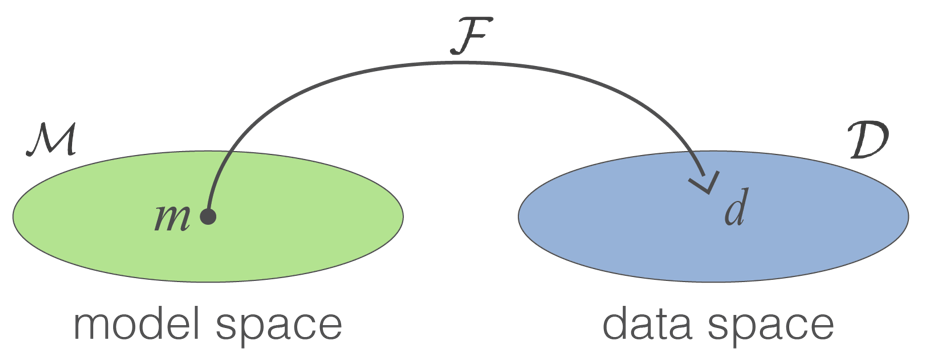Forward Mapping
Simulating data requires being able to solve
where is an element of the model space , and is the forward mapping. encompasses the physics of the problem, the geometry of the survey and details about Tx and Rx. The operation generates a simulated data set which is an element of data space . The procedure is conceptualized in the diagram below (Figure 1).

Figure 1:Mapping between model space and data space
1Model space¶
Model space is a vector space with key components. Its elements can be functions or Euclidean vectors. Model space comes equipped with two important attributes:
- Rules for inner products
- This allows the concept of angles between elements to be computed. This allows us to determine whether elements are parallel or perpendicular to each other.
- Norms to measure length
- In our optimization solution it will be important to measure the “length” of the vectors so that we can distinguish between small and large elements.
See Parker (1994) for a more in depth discussion.
For our seismic refraction problem (Section 1) our model space elements can be functions or an -length vector of velocity values: . These are shown in Figure 2.

Figure 2:Model space elements can be functions or -length vector of velocity values.
2Data Space¶
Observed data are generally a set of numbers and are consolidated into an elements of data space . Each datum is calculated using
The subscript allows us to keep track of specifics for that datum, such as survey parameters, which field, etc.
3Forward Mapping Operators¶
The forward mapping operator is problem dependent and can be formulated as an integral or differential operator. Fundamentally however, it is useful to distinguish between two types: linear and nonlinear operators. Linear operators are the easiest to deal with in an inverse problem and understanding them forms a solid foundation for attacking nonlinear inverse problems.
3.1Linear and Nonlinear Mappings¶
Let and be two elements of the model space and α and β be two constants. A mapping is linear if and only if
When this does not hold, the mapping is said to be nonlinear.
Many linear functionals can be written in integral form. A generic representation that we will use is
where is the datum, is the associated kernel function, and is the model of interest. (4) is a Fredholm equation of the second kind and it often appears in physical literature.
For example the equation for convolution,
takes the following form
In reflection seismology could be the reflectivity function, a wavelet, and an output seismogram. With reference to (4), each kernel is a time shifted version of . Another form of our linear system ((4)) is the Biot-Savart equation
Here the model is a vector, where is the current density, the kernel is the geometric function inside the integral and is the magnetic flux density.
We first show that (4) is a linear mapping. Suppose we have two models and , a kernel and two datum and .
The new datum, which is formed by a linear combination of the two models ((2) and (3)) is given by
and so the linearity condition in (4) is satisfied. This is to be contrasted with an example like
This is clearly a nonlinear relationship; if increases by a factor of two then the datum in increased by a factor of four.
Another example of nonlinearity is that encountered in DC resistivity. The controlling differential equation is
where is the electrical conductivity, is the potential which are the data, and the right hand side is a source. Doubling is will not result in a doubling of V.
The seismic refraction problem, is also a nonlinear mapping between travel time and velocity. Doubling the velocity of the earth will not increase the travel time by a factor of two. In fact, the majority of problem we deal with in geophysics are nonlinear.
- Parker, R. L. (1994). Geophysical Inverse Theory (Vol. 1). Princeton University Press. 10.2307/j.ctvs32s89
- Sheriff, R. E., & Geldart, L. P. (1995). Exploration Seismology (2nd ed.). Cambridge University Press. 10.1017/CBO9781139168359